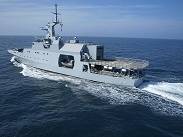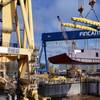Colombian Naval Industry Grows Stronger
“A.R.C. 20 de Julio”, joins the National Navy fleet.
• 300 direct work posts and 1500 indirect work posts generated by Cotecmar through the construction of this vessel.
A new milestone has been accomplished this week in Colombia’s corporate history. The delivery of the “A.R.C. 20 de Julio” vessel by Cotecmar to the Colombian Navy consolidates the reemergence of an industry that, until recently, was not too widely known in our country. It is the shipyard industry, which, by means of its endeavors in terms of scientific and technological development, has made for Colombia’s entry to the exclusive group of Latin American nations comprised by Brazil, Mexico, Peru and Chile that are building their own sea warfare vessels.
Cotecmar (Science and Technology Corporation of Naval, Maritime and Riverine Industry Development) was created by the initiative of the Colombian National Army through a strategic association with Nacional University, Norte University and Tecnológica de Bolívar University. Today present, thanks to the support of the Navy’s Command and that of the National Government, Cotecmar proudly presents the biggest and most complex ship ever built in our nation’s history at a value of 130 billion pesos (US$70 million).
This project, as of its first few days, positively leveraged and influenced over Cartagena City’s social and economical growth as well as that of the Colombian Caribbean Region and the Nation at large. In building this ship, nearly 300 direct work posts and 1500 indirect work posts were generated over the course of the vessel’s construction and, to this date, with all due patriotic pride, the Colombian Navy can now say that it counts on a sea unit entirely built by means of domestic labor.
Staff training was one of the key factors of the project’s success. Colombian professionals, naval architects and engineers, mechanics, designers, draftsmen and others, with graduate diplomas from Spain, the U.K., Brazil and the U.S., were signed into the process of the ship’s design and construction. They managed to build innovative processes into the construction strategy and incorporated world class technology in various processes ranging from automation, electric and hydraulic systems, all the way down to naval welding processes.
The support of our providers in this type of construction endeavors is essential, because this industry is one of synthesis. The national industry’s participation was represented by 220 companies from all over the country that added up more than 4,000 business transactions for the OPV’s construction process alone.
This is the reason why Cotecmar’s and the nation’s geostrategic horizon towards the year 2022 is focused on strengthening the shipyard industry’s technological development, thus seeking the consolidation of this sector as an important driver of Colombian economy, which may generate value, knowledge, employment and, most of all, prosperity for all.
Today present, the developed capacity, the knowledge and the experience acquired by Cotecmar are at the service of the National Navy and of the nation as a whole; the immediate intent is to position Colombia within the group of ship construction and exporting countries, both in the field of security and defense as well as general duty vessels.
The design and construction capacity acquired by Colombia is reaching for the future through relationships that have begun to take on great importance abroad; that is the reason the National Navy is now leading, with Cotecmar’s support, the following projects:
The second generation of OPV’s will be outfitted with sensors and weapons that will increase their security capability on behalf of the nation’s maritime interests. Cotecmar has already started the construction process of the second OPV, which shall go into service by December, 2013.
The construction of Coastal Patrol Vessels (CPV) in Colombia, which can be adapted, in terms of characteristics, to the operational needs and demands that the National Navy’s strategy has defined so that the Coast Guard Corps may continue fulfilling its mission efficiently and so that all investments as well as the offshore and coastline growth can be insured in the short and mid terms.
The construction of the new Logistical and Coastal Support Vessels will start to allow the offer of services within the next few years in terms of riverine support across the nation’s hard-to-reach areas. This type of units will come to back up the government’s social work and the strategy to consolidate the social growth of isolated communities by means of the humanitarian tasks the vessels will have the capacity to develop.
Such vessels may be exported to foreign countries that share our very same usage of both the Atlantic and Pacific oceans and that may require low-cost solutions for any issue affecting transportation and communication.
Currently, Cotecmar is pushing forward the construction of a 70 Bollard Pull Offshore Tugboat with steel hull and structure, which shall be delivered this year. With this type of ships, Cotecmar becomes a serious technological alternative for the construction of vessels to support the offshore oil exploration and production now being led by Colombia.
Other Construction
Cotecmar has managed to develop significant breakthroughs in the Naval Industry and, specifically, in the river-based component by means of the three (3) generations of the PAF-P (Heavy River Support Patrol Vessels) Project, which was qualified as a technological innovation by the National Science and Technology Council, and was given an award by the Colombian Association of Scientific Advancement. Additionally, this group also includes the PAF-L (Light River Support Patrol Vessels), LPR (River Patrol Speedboats) and other developing projects such as the design and construction of ECF (River Warfare Elements), the CPV (Coastal Patrol Vessel) and the second generation OPV (Ocean Patrol Vessel) as well as the BALC-F (Logistical and Coastal Trade Support Vessel).
“In the near future, Cotecmar not only aspires to become the ideal ship building alternative for the Colombian Navy as well as for the offshore and port sectors, but also expects to morph into a leading company in the development of products to support Colombia’s maritime and riverine growth”, the words of Rear Admiral Roberto Sáchica Mejía, President of Cotecmar.
Why “20 de Julio” (July 20th)
The ship was named “20 de Julio" with the purpose of joining in the celebratory events of our Independence Bicentennial.
This OPV-Type Vessel is the Navy’s second unit to have been given this name, as the first one was the “A.R.C. 20 de Julio" Destroyer, built in Malmo, Sweden, back in 1958.
The construction project of the “A.R.C. 20 de Julio” Exclusive Economic Zone Patrol Vessel, whose hull bears the number 46, started off in March, 2009 and involved, including direct and indirect employees, over 2,500 Colombian nationals.
“A.R.C. 20 de Julio" is the first ocean unit built in Colombia by domestic labor and in compliance with all applicable international standards and regulations; besides, it is the first Colombian naval unit certified and classified, both in terms of design and construction, by a first order international Classification Society such as Germanischer Lloyd, based in Germany.
“A.R.C. 20 de Julio” represents a step further in Colombia’s technological independence by means of the construction of its own warfare units with the purpose of reinforcing the Nation’s security and defense. This characteristic, shared only by a select group of countries in the world, translates into practice as the transfer of high level technology, thus greatly contributing to Colombia’s economic and technological growth.














